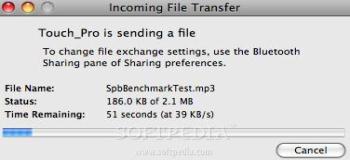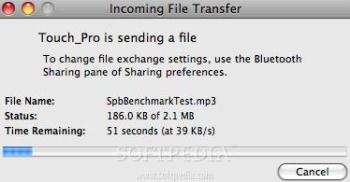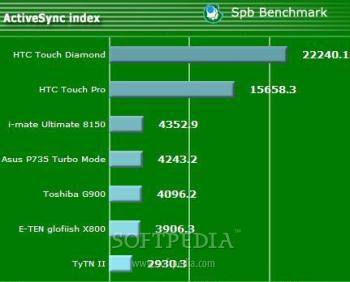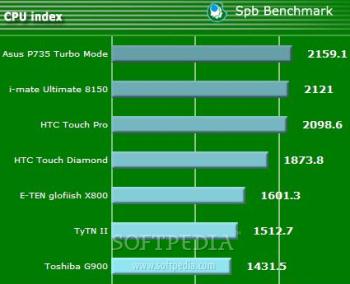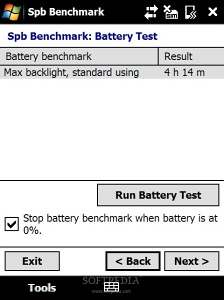In an attempt to meet the expectations of more smartphone users, the Taiwanese company HTC decided to improve its HTC Touch Diamond Windows Mobile device, by endowing it with a generous QWERTY keyboard. Those that were frustrated by the lack of a full QWERTY in the previous Touch Diamond model will be happy to find that HTC Touch Pro meets this requirement, and adds countless other stuff. Users won't find many changes in design, except for the thickness of the new Touch Pro, which is beyond any expectations. HTC Touch Pro doesn't come with anything innovative save that it adds more power and functionality to the previous Touch Diamond Pocket PC.
Announced in June 2008, HTC Touch Pro was made available on the market in August 2008. The slider smartphone from HTC can be acquired for about US$750, but pricing can vary, and depends on location or plan.
Design
If you are familiar with the HTC Touch Diamond design, then you won't notice too many differences compared with the Touch Pro device. Both come in the same size (102 x 51mm), but the thickness varies: 11.5mm for Touch Diamond, while Touch Pro has 18.1mm. The difference is huge also when it comes to their weight: 110g compared with Touch Pro's 165g (including battery). So, basically, you have the front of the Diamond, but the back of the phone has been completely reshaped. While HTC has kept the same diamond pattern on the battery cover of the device, the compound is mat plastic, and is something similar to the rubber-like material that has been used for so many other handsets as well – still, it is not quite the same. Actually, this is a good move on part of HTC, as the Touch Diamond had issues with the back cover, in that it was peeling off after heavy use.
The layout of ports and keys is much the same as on the previous Touch Diamond model. The middle D-pad button acts like a touchpad as well (much like a wheel), especially when zooming pictures in the Album area, browsing the Internet or when using the music player. There are two volume keys on the left side of the phone, and the miniUSB port on the bottom side, where you can insert the charger, a miniUSB cable for PC synchronization, or the headset that comes in the sales package. The Power button is placed, as usual, on the top side of the phone, and it can also be used to activate the phone when in standby mode. A very small ambient light sensor, the in-call earpiece, and a secondary VGA camera that can be used for video-calls have been placed above the 2.8'' display.
Below the screen, there are only four keys that can be used to control the menu of the phone, in case you don't want to touch and grease your device. The magnetic stylus can be pulled out from the bottom right part of the phone. The 3.2 Megapixel camera on the back doesn't have any protective lense, but it's placed a little bit behind a slim metallic plate, so it's not that easy to cause damage to it. A LED flash and a loudspeaker are also near the module camera.
Overall, I wasn't impressed by the new HTC Touch Pro device, and I noticed only a few differences compared with Diamond, but more similarities. Still, it is these differences that are important, as they make the smartphone seem appealing even to those who already own a Diamond right now.
Display and Camera
HTC Touch Pro embeds a large 2.8'' VGA touchscreen that supports 262k colors, but only displays 65k colors. The device supports a better resolution than most of the existing Pocket PCs on the market - 480x640 pixels.
Together with the new TouchFLO 3D interface, the screen offers marvelous quality viewing, which greatly improves Internet browsing and viewing of pictures. Just like with its Diamond predecessor, HTC literally outdid itself when developing such an incredible level of touch and view interaction. Thanks to the innovative TouchFLO 3D interface, HTC Touch Pro is very much comparable with the iPhone in terms of the level of sophistication of the interface. The screen is very responsive to the touch, and pretty much readable even when exposed to strong sunlight.HTC Touch Pro's 3.2 Megapixel camera features autofocus and flash capabilities. As is the case with Diamond users as well, you don't have a dedicated camera key so, in order to be able to take pictures, you'll have to use the large D-pad. Still, there's a trick that you might like and that's the "Touch and press" function. Basically, you can take advantage of the autofocus function by touching the D-pad. After the camera is focused, pressing the button will actually take the picture.
Even if the fact that the device lacks a camera button placed on either of the two sides is a bit annoying, the innovation introduced by HTC, back when the Diamond smartphone was available on the market, makes it a worthy change. In terms of quality, HTC Touch Pro is a considerable improvement over its Diamond “brother.” The plastic placed on the lenses of the Diamond, which was also the reason why pictures were sub-mediocre, has been eliminated. In fact, as you can notice form the sample pictures, the camera does way above-average snapshots. The 3.2 Megapixel camera of Touch Pro can be considered one of the best ever embedded in an HTC smartphone. The interface of the camera is rich in settings, with functions such as Brightness, White Balance, and Effect. Macro mode can also be used with ease, without the need of actually selecting the macro mode available. Movies can be recorded in MPEG4 formats, but you will only get CIF mode recording at 30fps (352x288 pixels). You can even use the secondary camera placed on the front of the phone to take pictures of yourself. Overall, the camera is one of the pleasant surprises offered by HTC to its fans. Now, if only it also featured the geotagging function, it would have been perfect. Nevertheless, I believe that the Taiwanese company is taking into consideration all the feedback it receives from users, and further improves its devices.Menu and Software
HTC Touch Pro runs Microsoft Windows Mobile 6.1 Professional operating system, featuring the 3rd version of the TouchFLO interface. The latter provides animated access to people, messaging, email, photos, music, weather and more. In addition, HTC introduces an innovative touch-sensitive control for interacting with Touch Pro. While the TouchFLO 3D enables finger swipe navigation through menus, the acclaimed accelerometer sensor automatically pivots the screen orientation from portrait to landscape when browsing the Internet, playing games, listening to music, or when just watching a movie or looking at pictures.
These functions only work when the TouchFLO interface is active, and not when you're browsing the Programs or Settings areas. The interface is simply breathtaking, and will certainly catch your eyes even if you're not a Windows Mobile lover. HTC Touch Pro has been equipped with only the latest applications that somewhat emulate the iPhone's interface: YouTube client application, Google Maps (and GPS), Windows Media Player 10, Opera Mobile 9.5, Windows Live Messenger, Widget for weather forecast, Audio Booster, Album, Streaming Media Player, MP3 Trimmer, Adobe Reader 2.5, Esmertec Java emulator, and Games. The tweaks and improvements that HTC introduced to the phone's interface greatly increase its functionality. One of these improvements is the Task Manager, which has been placed on the top right of the screen, near the signal and battery icons. With a simple click, you'll now be able to close all applications left opened. Basically, when you want to access one of the areas represented by the icons on the upper right part of the screen, you'll be able to visualize a small submenu (System Status), where you'll be presented with several choices, such as, Communications panel, Ringtones profile, Battery status, Data connectivity, and more. Unfortunately, I noticed that, after frequent use, and especially when you need to open the Communications menu, the device will simply refuse to display the sub-menu no matter how many times you try. The features of this device are much the same as Diamond's. The End key (Reject calls) can be predefined to execute various actions when it is pressed for about 3-4 seconds. Users will have the choice to turn the device to Airplane Mode, lock the device, Terminate data connection, Set the Vibrate/Ringer profile, or they can simply opt for the function to display the Quick List. The list consists of the same options mentioned earlier, but also offers the possibility of going directly to the Settings area. The latter can also be accessed by swiping your finger on the Home page until you reach this area, and features another set of functions: Sync Data, Sound, Wallpaper, Communications, Data (Weather data download). Navigation can be easily done without the need of a stylus, by swiping your finger to the right or to the left on the Home screen. This way, the 3D interface offers easy and quick access to areas to which you had a long way to go when using other Pocket PCs that did not support this feature. Besides the Programs bar that displays the applications that you like to use more frequently, and which can be viewed when pressing the Start icon, the device also features a panel where you can add or remove various programs, games and such, as you best like it. To facilitate the writing method and in order to come to the aid of those who are used with various inputting methods, HTC introduced 4 types of keypad layouts: Phone keypad, Compact QWERTY, Full QWERTY and Keyboard. For business people, HTC included the Office Mobile package, which now also comprises the OneNote Mobile application, besides the usual Excel, PowerPoint and Word Mobile programs. Handwriting recognition is also a nice addition. Notes application can be accessed even when talking on the phone, allowing you to write down any information you need. The touchscreen offers you a couple of nice functions, like zooming in and out when browsing the Internet or when viewing pictures. This can also be done from the Touch-pad, granted you don't want to soil you screen. To zoom in on a picture, you have to touch and rotate your finger to the left or to the right on the D-pad. The same goes for the screen, if you simply don't care if your phone gets stained or not. Gamers will be happy to notice that the highly-addictive Teeter game has been also included in the device's OS. It takes advantage of the built-in accelerometer, inviting people to guide a ball through various mazes.Communication
HTC Touch Pro takes advantage of the HSDPA 7.2 Mbps and HSUPA technologies to deliver a complete mobile Internet experience. Besides HSDPA technology, as a much cheaper choice, one can opt for EDGE Class 10 connectivity, but data transfer speeds will be considerably lower. Unfortunately, neither of the two technologies works at maximum capacity, offering only moderate results (111 Kbit/s download and 71 Kbit/s upload for EDGE; 593 Kbit/s download and 96 Kbit/s upload for HSDPA). However, at least, it seems that the HTC Touch Pro is superior to Diamond, where test results are concerned.
It has become a well-known fact that HTC devices have a very low 3G signal, regardless of the area where they are being used. Sadly, the same goes for the Touch Pro.Furthermore, the device features Wi-Fi 802.11 b/g technology, Bluetooth v2.0 with A2DP and miniUSB 2.0. I tested the speed of the Bluetooth data rate transfer, and I was a bit disappointed. While the receiving speed is above average (around 89 KB/s), the sending speed is below mediocre (only 39 KB/s). Either way, the device includes a wide range of connectivity options, most of these being wireless (Wi-Fi, HSDPA, aGPS).
The HTC Touch Pro supports SMS, MMS and email. Thanks to the 3D interface, users will be able to thumb scroll longer messages in the Inbox. Dynamic font resizing (zooming in/out with the scroll wheel) is also available. HTC Touch Pro also offers Message delivery reports in its Settings menu. Furthermore, the blinking touch-pad "highlights" messages received when the phone is in standby mode, which I consider quite a nice touch. The same goes for missed calls. Regarding the phone's capabilities, the HTC Touch Pro is compatible with GSM900, GSM1800 and GSM1900 networks, which will widen its usage around the world. There's also an American version of the phone that supports GSM 850 / 1800 / 1900 networks.In terms of telephony, HTC Touch Pro is a real disappointment, as I have found the in-call volume to be very low, which makes phone conversations in noisy areas impossible.
Processor and Memory
HTC Touch Pro is powered by the same Qualcomm MSM7201A 528 MHz chipset, which includes a dual-core processor. One thing that I noticed when browsing through menus was the lag of the device, as if it didn't have enough power.
Once I updated to the latest ROM version, everything was working smoothly. So, if you don't have the latest ROM, I suggest doing the update immediately. For more insight on HTC Qualcomm CPUs, check out our forum here. The device comes with 288 MB DDR SDRAM, 512 MB ROM, which means it has double memory, as compared with Diamond. Moreover, the device supports microSD cards up to 8GB, as opposed to Diamond, which had only 4GB internal memory and no slot card for memory expansion.Multimedia
HTC Touch Pro doesn't look like the perfect MP3 player to be put in a youngster’s pocket at all. Its bulky construction and heavy weight recommend it more as a business phone, especially thanks to the full QWERTY keyboard. The music player strongly resembles Apple's iPod, but that was the idea after all. It uses album art and visualization, and features a rich Library that can be used to sort files by artist, genre, or composer. I did not notice any hiccups when running various music files, but anything is possible. Unfortunately, the most important aspect related to music, the Equalizer, can only be accessed when the headphones are inserted.
The device comes with some crappy earphones (HS S300), which don't feature a 3.5mm audio jack adapter. Mediocre is the word of the day, when talking about sound quality of the music rendered. You may probably want to change the headphones, but you need to buy yourself a dedicated HTC set with 3.5mm audio adapter (HS U110 e.g.). If you get the same sound as with the Diamond when attaching better headphones, then you will easily be able to compare it with iPhone's music sound. FM radio is also included, and can sum up 20 base stations. The dedicated video player only runs movies that feature Windows-compatible codecs. The latest ROM provides a really smooth video playback experience, with no skipped frames or lags.Battery
HTC Touch Pro features a large 1340 mAh Lithium-ion battery, with an official stated autonomy of up to 406 hours in standby mode, and up to 8 hours of talking time.
Again, these numbers are overrated, with the Touch Pro offering, in fact, only half of that talking time, as you can see from the screenshots. Nevertheless, this is an improvement from Diamond's 900 mAh Li-ion battery, which was good only for 2 hours and a half.Impressions
After playing with HTC's Touch Diamond, Touch Pro did not impress me. The device seems more “serious,” and will probably be picked up mostly by businessmen. If you want to see how a phone (Touch Diamond) can be turned into a brick, then, by all means, check out Touch Pro. While it does have some style, its weight and bulkiness may annoy the “audience.”
The Good
The Bad
The only thing that may prevent one from buying Touch Pro is definitely its bulky form factor. I can understand that adding a full QWERTY keyboard is important and requires some space, but I still think that 18.5mm in thickness is a little bit over the limit these days. Last but not least, I think that more accessories in the sales package would have made it more attractive for potential buyers.
Sales package
HTC Touch Pro handset 1340 mAh Lithium-ion battery USB to PC sync cable AC Power Adaptor Spare Stylus HS S300 earphones Manual CD-ROM
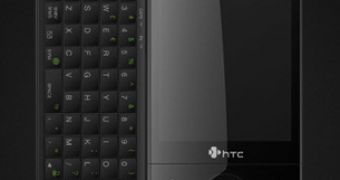
 14 DAY TRIAL //
14 DAY TRIAL // 

















































































